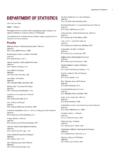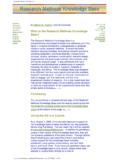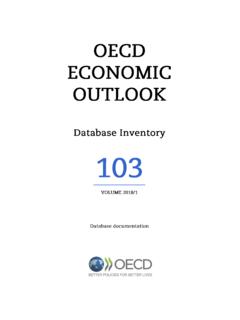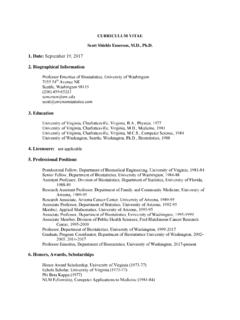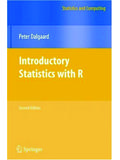Transcription of Guidance for Calculating the 95% Upper …
1 STATE OF connecticut department OF ENERGY AND ENVIRONMENTAL PROTECTION Guidance for Calculating the 95% Upper Confidence Level for Demonstrating Compliance with the Remediation Standard Regulations May 30, 2014 Robert J. Klee, Commissioner 79 Elm Street, Hartford, CT 06106 860-424-3705 i TABLE OF CONTENTS LIST OF ACRONYMS iii DEFINITION OF TERMS iv 1. Introduction 1 Definition of 95 % Upper Confidence Level 1 Data Quality Considerations 2 Applicability 2 Soil 3 Groundwater 3 Document Organization 4 2. Developing a Data Set for a Release Area 4 Data Selection for 95% UCL Calculation for a Release Area 5 Non-Detect Soil Results in a Release Area Data Set 7 Quality Control Soil Sample Results in a Release Area Data Set 7 3. Developing a Data Set for a Groundwater Plume 7 Data Selection for 95% UCL Calculation for a Groundwater Plume 8 Non-Detect Results in a Groundwater Plume Data Set 8 Quality Control Results in a Groundwater Plume Data Set 8 4.
2 Evaluating the Data Set 9 Distribution of COC Concentrations in the Environment 9 Appropriate Data Set Size 10 Statistical DQOs 10 Randomness of Data Set 10 Strength of Data Set 10 Skewness of Data Set 11 5. Statistical Calculation Methods 11 ii Data Distributions 12 Handling of Non-Detect Results in Statistical Calculations 12 6. Requests for Alternative Method for Demonstrating Compliance Using the 95% UCL 12 7. References 14 Example 1. Effect of Collection of Additional Samples after Delineation 16 Appendix A Laboratory Analytical Limits and How They Affect Non-Detect Results 20 Appendix B Summary of UCL Calculation Methods 21 Appendix C ProUCL Version Calculation Method Decision Summary Tables1 22 iii LIST OF ACRONYMS 95% UCL Ninety-five percent Upper confidence level of the arithmetic mean COC Constituent of Concern CSM Conceptual Site Model DEC Direct Exposure Criteria DPH department of Public Health DQO Data Quality Objective GWPC Groundwater Protection Criteria KM Kaplan-Meier MDL Method Detection Limit PMC Pollutant Mobility Criteria QC Quality Control RL Reporting Limit ROS Regression on Order Statistics RSR Remediation Standard Regulation SCGD Site Characterization Guidance Document SWPC Surface Water Protection Criteria iv DEFINITION OF TERMS Term Definition Analyte An analyte means a substance being measured by a laboratory analytical
3 Procedure. Gamma Distribution Gamma distribution is an arrangement of data in which applying the gamma function transforms the data to have a normal distribution. The gamma function is an extension of the factorial function. Lognormal Distribution Lognormal distribution is an arrangement of data in which the logarithms of the data have a normal distribution. Method Detection Limit A method detection limit is a statistically-calculated result used to evaluate precision and accuracy of analytical results obtained by a given method process. (further details are provided in Appendix A) Non-Detect A non-detect is an analytical result that is below the level that could be detected or reliably quantified using a particular analytical method. Non-Parametric Non-parametric describes statistical methods that do not assume that the data set has any known distribution. Non-parametric methods make few assumptions about the underlying distribution; therefore, they can be applied to data sets with any distribution, including those that are unknown.
4 Normal Distribution Normal distribution is an arrangement of data graphically represented as a bell-shaped frequency curve symmetrical about the mean. Randomness Randomness of the data set is the degree to which the introduction of bias has been reduced and the resulting data points are more likely to be independently and equally distributed within the population ( , release area, groundwater plume). Reporting Limit The reporting limit is the minimum concentration of an analyte that can be reliably quantified and reported by the laboratory using a specific laboratory analytical method during routine laboratory operating conditions. Reporting limits are determined by the laboratory, are above instrument detection limits, and are adjusted based on laboratory and sample conditions. (further details are provided in Appendix A) Skewness Skewness is the degree to which a data set is not in balance around the mean (asymmetrical or lopsided).
5 Distributions with extreme values (outliers) above the mean have positive skew, and the distributions with outliers below the mean have negative skew. Strength Strength is a measure of the relationship between variables. The strength of the data set is directly related to the size of the data set. The larger the data set size, the stronger the data set and therefore the more reliable and robust the results of the 95% UCL estimate. 1 1. INTRODUCTION In accordance with the connecticut Remediation Standard Regulations (RSRs), Sections 22a-133k-1 through 22a-133k-3 of the Regulations of connecticut State Agencies, the ninety-five percent Upper confidence level of the arithmetic mean (95% UCL) is a self-implementing option that may be used to demonstrate compliance with the direct exposure criteria (DEC), pollutant mobility criteria (PMC), groundwater protection criteria (GWPC), and the surface water protection criteria (SWPC).
6 A workgroup consisting of personnel from the department of Energy and Environmental Protection ( department ) and the department of Public Health (DPH), along with environmental professionals from the private-sector, developed this Guidance for Calculating the 95% Upper Confidence Level for Demonstrating Compliance with the Remediation Standard Regulations (Document) to guide the regulated community in performing the 95% UCL statistical calculation on soil and groundwater data sets to demonstrate compliance with certain RSR criteria. Definition of 95 % Upper Confidence Level The ninety-five percent Upper confidence level of the arithmetic mean is defined in the RSRs as a value that, when repeatedly calculated for randomly drawn subsets of size n from a population, equals or exceeds the population arithmetic mean ninety-five percent of the time. The arithmetic mean is calculated by adding up all the numbers in a data set and dividing the result by the total number of data points.
7 This is quite different than a geometric mean, which is calculated by multiplying the numbers in the data set, and taking the nth root of the result. In order to use the 95% UCL to demonstrate compliance with the RSRs, it is important to ensure that the 95% UCL is calculated for the arithmetic mean (intended to be used when the individual data points are independent of each other), since the use of the geometric mean (intended to be used when the individual data points are dependent on the previous data points) would be inappropriate. Fig. 1 - Graphical Representation of the 95% UCL 2 Data Quality Considerations Data quality objectives (DQOs) are specific goals developed to ensure that a sufficient quality and quantity of data are collected to make appropriate decisions. Prior to demonstrating compliance with applicable RSR criterion, the environmental professional is expected to have completed the characterization of the subject release area or groundwater plume in accordance with prevailing standards and guidelines, including the department s Site Characterization Guidance Document (SCGD)1.
8 Data collected according to DQOs related to the characterization of the site may or may not support the use of statistics to demonstrate compliance. Prior to Calculating the 95% UCL to demonstrate compliance, the environmental professional should ensure that the data set meets the underlying assumption of the statistical methods used in the calculation. For example, the statistical methods described in this Document for Calculating the 95% UCL are based, in part, on the assumption of random sampling. During the investigation and characterization of sites, sampling is typically focused on identifying and delineating areas of contamination. Such sampling program will likely produce a biased data set with samples mostly collected for delineation, which represent the lower concentrations of the release area rather than being randomly distributed throughout the release area. This resulting data set would not be appropriate for use in a 95% UCL calculation without the collection of additional samples from the underrepresented sections of the release area.
9 The environmental professional needs to ensure that the particular data set is of sufficient quality and quantity (as discussed in Section 4) to represent the subject release area or subject groundwater plume to use with these statistical methods. The collection of additional samples may be necessary to meet the underlying assumptions of the statistical methods. Applicability This section provides an overview of the provisions of the RSRs that provide the option to use a 95% UCL to demonstrate compliance. In the event of inconsistencies between this Document and the RSRs, the language in the regulations supercedes this Document. In addition, under certain circumstance Federal Regulations may also apply which may limit the applicability of this Guidance Document. 1 The department s Site Characterization Guidance Document (dated September 2007, revised December 2010) provides the department s recommendations for the multi-phased approach to site characterization using conceptual site modeling.
10 3 Soil The RSRs allow the calculation of a 95% UCL to demonstrate compliance with the DEC and the PMC for an individual release area. Direct Exposure Criteria Section 22a-133k-2(e)(1) of the RSRs provides the option to demonstrate compliance with the applicable DEC if the 95% UCL of all soil sample results from the subject release area is equal to or less than the applicable DEC. Accounting for any institutional controls implemented, only those soil sample results from locations and depths where the DEC apply should be used to calculate the 95% UCL for DEC compliance. Pollutant Mobility Criteria Section 22a-133k-2(e)(2)(A) of the RSRs provides the option to demonstrate compliance with PMC if the 95% UCL of at least 20 samples collected from the subject release area and above the water table is equal to or less than the applicable PMC. Accounting for any institutional controls implemented, only those soil sample results from locations and depths where the PMC apply should be used to calculate the 95% UCL for PMC compliance.










